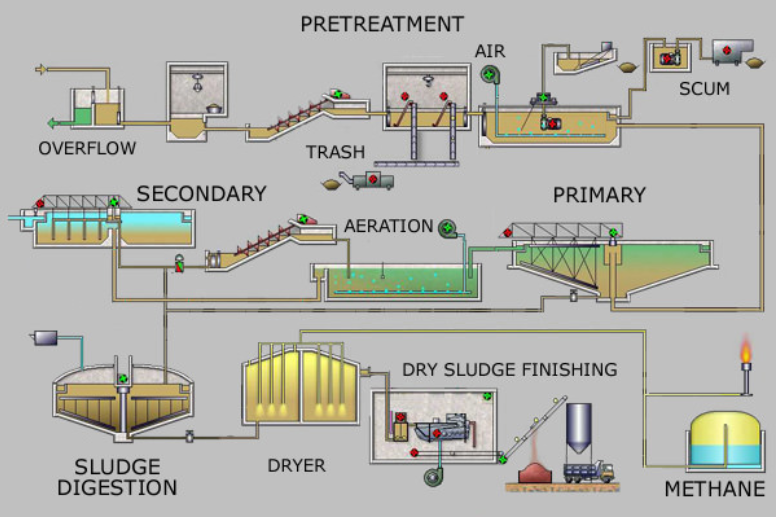20.1.2: Water Treatment
- Page ID
- 31654
The most deadly form of water pollution, pathogenic microorganisms that cause waterborne diseases, killed 485,000 million people (mostly in developing countries) in 2017. The best strategy for addressing this problem is proper sewage (wastewater) treatment. Untreated sewage is not only a major cause of pathogenic diseases, but also a major source of other pollutants, including oxygen-demanding waste, excess nutrients, and toxic heavy metals. Wastewater treatment is done at a sewage treatment plant in urban areas and through a septic tank system in rural areas.
The wastes generated by some 80% of U.S. households are collected in sewer systems. Each day, the United States processes about 34 billion gallons of wastewater (99.9% of this is water). In 2004, an Environmental Protection Agency (EPA) report estimated that 860 billion gallons of untreated wastewater (raw sewage) escaped into rivers, streams, and the ocean, mainly from combined sewage systems (see Water Pollutants and Their Sources). As of 2020, the EPA has assessed nearly 96% of the systems responsible for wastewater overflow and addressed them with a civil complaint, enforcement order, or permit requirement. However, in 2017, the EPA estimated that were still 40,000 or more wastewater overflow events, which released raw sewage into bodies of water.
To reduce water pollution problems, separate sewer systems (where street runoff goes to rivers and only wastewater goes to a wastewater treatment plant) are much better than combined sewer systems, which can overflow and release untreated sewage into surface waters during heavy rain. Some cities such as Chicago, Illinois have constructed large underground caverns and also use abandoned rock quarries to hold storm sewer overflow. After the rain stops, the stored water goes to the sewage treatment plant for processing.
Wastewater Treatment
The sewage that is properly directed to a wastewater treatment plant undergoes several steps: pretreatment, primary treatment, tertiary treatment, and disinfection and discharge (figure \(\PageIndex{a}\)). Pretreatment involves the screening and removal of sand and gravel. Primary treatment involves settling or floatation to remove organic solids, fat, and grease. The undissolved solids in raw sewage to settle out of suspension forming sludge. Such primary treatment removes only one-third of the biological oxygen demand (BOD) and virtually none of the dissolved minerals. Attempts to use digested sludge as a fertilizer have been hampered by its frequent contamination by toxic chemicals derived from industrial wastes.

Next, the organic solids in the effluent are decomposed by aerobic (oxygen-requiring) bacteria in secondary treatment. Here the effluent is brought in contact with oxygen. Aerobic microorganisms break down much of the organic matter to harmless substances such as carbon dioxide. Primary and secondary treatment together can remove up to 90% of the BOD. After chlorination to remove its content of bacteria, the effluent from secondary treatment is returned to the local surface water.
The concentrated organic solid produced during primary and secondary treatment (sludge) is treated in a variety of ways including landfill disposal, incineration, use as fertilizer, and anaerobic bacterial decomposition, which is done in the absence of oxygen. Anaerobic decomposition of sludge produces methane gas, which can be used as an energy source.
Although the combination of primary and secondary treatment removes most of the organic matter in sewage, lowering BOD, most of the nitrogen and phosphorus in sewage remains in the effluent (liquid portion of the sewage). In tertiary treatment, bacteria are used to remove the remaining nutrients, and filtration occurs. Additionally, several techniques are available to remove dissolved salts from sewage effluent, but all are quite expensive.
During disinfection, further treatment involves disinfection with chlorine, ozone, ultraviolet light, or bleach to kill most microbes. Finally, the treated water is discharged to surface waters (usually a local river) or reused for some other purpose, such as irrigation, habitat preservation, and artificial groundwater recharge
Septic Tank System
A septic tank system is an individual sewage treatment system for homes in typically rural settings. The basic components of a septic tank system (figure \(\PageIndex{b}\)) include a sewer line (inlet) from the house, a septic tank, and the drain field. The septic tank is a large container where sludge settles to the bottom, where microorganisms decompose the organic solids anaerobically. The drain field is a network of perforated pipes where the clarified water seeps into the soil and is further purified by bacteria. Water pollution problems occur if the septic tank malfunctions, which usually occurs when a system is established in the wrong type of soil or maintained poorly.

Addressing Water Treatment Globally
For many developing countries, financial aid is necessary to build adequate wastewater treatment facilities. The World Health Organization estimates an estimated cost savings at least $5 for every $1 invested in clean water delivery and sanitation. The cost savings are from health care savings, gains in work and school productivity, and prevented deaths. Simple and inexpensive techniques for treating water at home include chlorination, filters, and solar disinfection. Another alternative is to use constructed wetlands technology (marshes built to treat contaminated water), which is simpler and cheaper than a conventional sewage treatment plant.
Attributions
Modified by Melissa Ha from the following sources:
- Water Treatment from Environmental Biology by Matthew R. Fisher (licensed under CC-BY)
- Sewage Treatment from Biology by John W. Kimball (licensed under CC-BY)
- Former National Compliance Initiative: Keeping Raw Sewage and Contaminated Stormwater Out of Our Nation’s Waters. 2020. EPA. Accessed 01-18-2021. (public domain)


